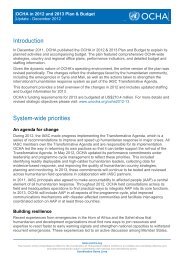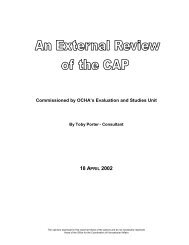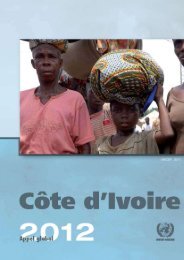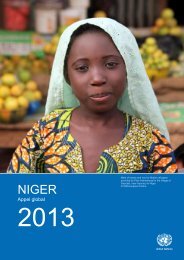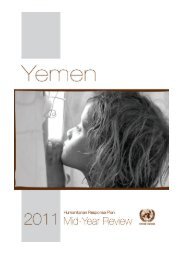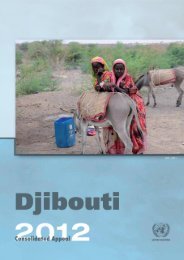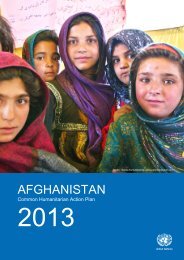LESOTHO <strong>DROUGHT</strong> FLASH APPEALFurthermore, casual labour wages have remained the same for the last three years (at 10 maloti or$1.41 per day) while prices for other commodities have increased significantly. For the poor and verypoor households who depend on casual labour for cash income, this translates to less ‘real’ incomethan three years ago if one takes into consideration for example the increase in the price of maize.Table A: Number of individuals requiring food assistance per livelihood zoneLivelihood Zones*Wealth Groups Foothills Mountains NorthernLowlandPeri-urban SouthernLowlandSenqu RiverValleyVery Poor 22,339 40,528 48,886 14,482 76,785 10,708Poor 0 123,514 0 34,075 0 29,982Total 22,339 164,042 48,886 48,557 76,785 40,690Grand total 401,299Source: Lesotho Vulnerability Assessment Committee; Vulnerability Assessment Report, April 2007The Lesotho Vulnerability Assessment Committee (LVAC), in conjunction with the Government’s Foodand Nutrition Coordinating Office (FNCO), issued a report in 2006 on the status of malnutrition inchildren under five. 15 The report focused on three indicators of under-nutrition:• Underweight, defined as low weight for age;• Wasting, a short-term type of under-nutrition defined as low weight for height; and• Stunting, a long-term category of under-nutrition defined as decreased height for age.The survey conducted by the LVAC, WFP and the FNCO in 2006 indicated a prevalence ofunderweight, wasting and stunting as follows: 18.4%, 2.4%, and 37.9% respectively, reflecting agradual increase in malnutrition prevalence since 2005. Community and Household Surveillance(CHS) conducted by WFP in March 2007 indicated an increase in prevalence of the three nutritionalindicators. The percentage of underweight children was estimated at 20%, while 6% were wasted and40% stunted. Although results are only indicative and require a nutritional survey to ascertain, theypoint to a deteriorating nutritional status of children under the age of five years, as outlined the tablebelow.152006 Nutrition Survey, LVAC and FNCO, GoL, Maseru, Lesotho, 2006.6
LESOTHO <strong>DROUGHT</strong> FLASH APPEALTable B: Comparison of % prevalence of underweight, wasting and stunting in 2006 and 2007Prevalence (%) by yearNutritional status 2006 2007Underweight 18.4 20Wasting 16 2.4 6Stunting 37.9 40Sources: 2006 – LVAC / WFP / FNCO Survey; 2007 – Community and HouseholdSurveillance, WFP, March 2007Always remembering that it is difficult to confidently identify a trend using nutritional data gathered withimperfectly consistent methods, it is nevertheless clear that the situation in Lesotho has worsenedconsiderably. Wasting, which is caused by relatively recent illnesses and food shortages, hassurpassed the international threshold of 5% for declaring a situation of concern. It is feared that thedrought will increase all of the underlying causes of acute malnutrition and vulnerability due to acombination of persistent food insecurity, poor access to sanitation, poor household child care andhygiene practices, and poor health care at household and community levels. This vicious circle willnegatively impact on acute malnutrition in June 2007 through to a peak at the end of 2007 andbeginning of 2008 if no immediate assistance provided.The statistics from the Ministry of Health and Social Welfare (MoHSW), Statistical Department alsopaint a picture of worsening conditions. In 2006, Government figures reveal that only 4.5% childrenfrom the 2,632 admitted to governmental hospitals were found to be severely malnourished, with 24%found to be suffering from acute watery diarrhoea (AWD) and dehydration. However, the latestadmission figures from Queen Elizabeth II Hospital (as a proxy) for the period January – July 2007indicate that already this year an average of 12% of cases admitted to the paediatric wards were dueto severe malnutrition, with a case fatality rate because of malnutrition around 25%. The deterioratingwater and sanitation system in the country is most evident in the health facilities: the MoHSWreported, following a recent internal survey of its facilities, that 60% of its health centres have noaccess to safe water. The same ministry provided data on 2006, which revealed that 85% of the outpatientsclinics’ consultations in all age groups are because of diarrhoeal diseases.The drought has also had a negative impact on water sources for domestic, livestock and agriculturaluse. By the end of the rainfall season in April, most households were already experiencing watershortages. Households reported rationing water from springs to extend its availability through thewinter season according to programme monitoring reports. Communal dams, an important source ofwater for livestock and homestead garden irrigation, were exhausted by the end of the rainfall season.Those who practice roof water harvesting also reported that stores were depleted by February.Although intermittent rain showers in April have somewhat reduced the severity of water shortage, it isevident that the coming months will witness a dramatic decrease in people’s access to safe domesticwater in sufficient quantities.HIV and AIDS ContextAccording to the Joint United Nations Programme on HIV and AIDS (UNAIDS), since 2003 23.2% ofthe adult population between the ages of 15 and 49 are infected with HIV. 17 It is estimated that thereare approximately 270,000 people, or 14% of the population, living with the virus in Lesotho, andabout 97,000 children who have lost one or both parents to AIDS. Households with members whoought to be productive but who are chronically ill face increased vulnerability in that they are forced toredirect meagre resources to the care and needs of the ill, who in turn are unable to provide economicsupport due to their prolonged incapacitation. Caloric and nutritional requirements increase in HIVinfectedhousehold members, while resources to provide food diminish.In addition, lack of access to food and nutrition can result in faster disease progression in people livingwith HIV but who have not yet developed full-blown AIDS. In some cases children leave school to findwork, subjecting them to increased vulnerability. Food insecurity may also expose vulnerable16A child who is below -2 standard deviations (SD, also called ‘Z scores’) from the NCHS/WHO reference median for weight-for-height isconsidered to be too thin for his/her height, or wasted, a condition reflecting acute malnutrition. If the individual is between -2 and -3 Z-scores, the condition is considered moderate acute malnutrition. If the individual is below -3 Z-scores, the condition is defined as severeacute malnutrition. Wasting therefore corresponds fairly closely to ‘global acute malnutrition’ (the latter being moderate plus severe plusthose exhibiting oedema). The Lesotho data on wasting summarised in Table B do not differentiate between moderate and severe.172006 UNAIDS Report on Global AIDS Epidemic7




